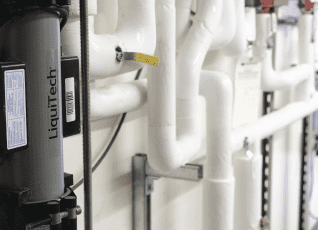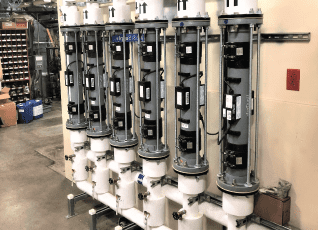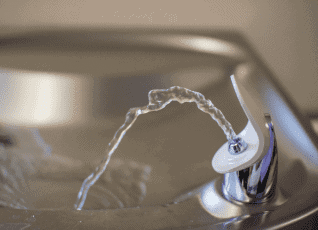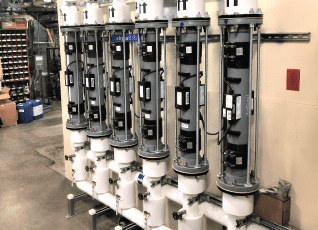Controlling Legionella Case Study: Chlorine Dioxide vs. Copper-Silver Ionization

In 2009, an outbreak of Legionnaire’s Disease hit a large Georgia hospital, affecting six wards, and resulting in the closure of 10% of their patient beds. After trying several solutions, including installation of continuous chlorine dioxide systems and plumbing infrastructure upgrades, the hospital still tested positive for Legionella. In 2023, the hospital partnered with LiquiTech to install a LiquiTech™ Copper-Silver Ionization System to control the Legionella contamination and reduce the risk of future disease outbreaks. Within just two months of installing copper-silver ionization, the Legionella positivity rate dropped from 100% to 11%, with the next round of testing showing 0% positivity. Through its ongoing service partnership with LiquiTech, the hospital has successfully maintained control of the Legionella contamination. By choosing the right technology and ensuring ongoing maintenance, the hospital’s priorities of protecting their staff and patients and controlling waterborne pathogens were achieved. To learn more, read the full case study here.
News Release: New Study Shows Copper-Silver Ionization is Effective for Legionella Control

Legionnaires’ disease cases have increased nearly tenfold in recent decades, leading to thousands of hospitalizations and deaths. Outbreaks are linked to Legionella, a bacteria found in potable water systems in large facilities like hospitals, multi-family buildings, resorts, and office buildings. A recently published study shows that copper-silver ionization effectively controls Legionella in building water systems to prevent Legionnaires’ disease. A new study published in the American Water Works Association (AWWA) Water Science journal shows that copper-silver ionization effectively controls Legionella in building water systems. The study, conducted by Dr. Mark LeChevallier with technical and financial support from LiquiTech, examines more than 80 sources of research studies and related literature to analyze the efficacy of copper-silver ionization as a water treatment solution. Dr. LeChevallier concludes “that use of copper-silver ionization to control Legionella and other opportunistic pathogens is highly effective when the units are properly designed, maintained, and operated.” Legionnaires’ disease cases have increased nearly tenfold in recent decades, leading to thousands of hospitalizations. Those who catch Legionnaires’ disease experience a severe form of pneumonia caused by Legionella, a bacteria found in poorly maintained water systems. Studies show that Legionella is responsible for about two-thirds of all disease outbreaks from drinking water and the cause of all documented deaths attributed to drinking water-associated infections. Historically, outbreaks were linked to cooling tower systems. As our understanding of Legionella has advanced over recent decades, most outbreaks are now connected to potable water systems in large facilities, such as hospitals, long-term healthcare facilities, resorts, and office buildings. It’s estimated that 54% of all potable building water systems have some level of Legionella present. Plumbing codes and regulations have been developed to standardize the design, structure, and management of building water systems to prevent waterborne diseases. However, based on the studies cited in this article and elsewhere, there is a need for supplemental treatment of building water systems. One such supplemental treatment is copper-silver ionization, a chemical-free disinfection solution for potable water systems. It releases copper and silver ions into the building’s water system to destroy waterborne pathogens like Legionella. Copper-silver ionization is not a new water treatment option. Silver ionization was used in the 1960s by NASA for the sanitation of water on spacecraft. In the 1980s, copper-silver ionization was used in swimming pools as an alternative to chlorine. Later, in 1994, copper-silver ionization was the first reported effective treatment for controlling Legionella in a hospital. Today, copper-silver ionization is used to prevent waterborne pathogens in a variety of buildings with complex water systems. Although copper-silver ionization is a low-cost and chemical-free option for water disinfection, the system must be designed properly and used in the appropriate applications to achieve optimal results. Crucial to its effectiveness is identifying and responding to abnormalities in water usage patterns and chemistry. Dr. LeChevallier, a drinking water research scientist with a Ph.D. in Microbiology, examined literature and studies related to copper-silver ionization system design, maintenance, and operations, and the impact water chemistry has on its performance. In addition to authoring more than 300 research papers, Dr. LeChevallier is a member of the Drinking Water Subcommittee of the Science Advisory Board of the United States Environmental Protection Agency (US EPA), a past member of the Water Science Technology Board of the National Academies of Science, and the past Chair of the AWWA Water Science & Research Division. In his recently published study, Dr. LeChevallier explained, “These water quality and operational characteristics must be properly addressed to assure that the highest disinfection efficacy is obtained through copper-silver ionization.” He reviewed research and related literature to investigate the mechanisms of copper and silver disinfection. Copper-silver ionization works by treating water through electrolysis. An electric current is applied to a copper and silver bar to produce and release positively charged ions. These copper and silver ions then find microorganisms in the water with a negative charge, like Legionella. The copper ions bond to the negative walls of the microorganisms, disrupting cell wall permeability and the absorption of life-sustaining nutrients. This disruption to the cell wall allows the silver ions to enter and destroy the core of the bacteria, thus making it impossible to survive. Dr. LeChevallier cited studies showing that copper and silver can work as biocides independently or together. One study emphasized that combined treatment with copper and silver was associated with decreased incidence of Legionella and a faster reduction of bacteria than copper or silver alone. In addition to copper-silver ionization being considered an effective supplemental method for water treatment by researchers, the US EPA has recognized both copper and silver as metallic antimicrobial agents. Studies show that copper-silver ionization is effective against many waterborne pathogens, including Legionella, Nontuberculous Mycobacterium, Pseudomonas, Stenotrophomonas, Acinetobacter, and fungi. While the issue of copper-silver resistance was discussed in portions of the literature that Dr. LeChevallier reviewed, it’s important to note that there was no evidence of it occurring with Legionella. Copper-silver resistance, where pathogens can continue to grow and thrive even in the presence of copper and silver, was only observed with E. coli and Salmonella. During his investigation, Dr. LeChevallier found that the design, operation, and maintenance of copper-silver ionization systems are critical to their effective functionality. In his published paper, he explained that copper-silver ionization will act as a water disinfectant; however, the proper engineering and operation of the system are integral to its success. Essential components of the copper-silver ionization system include the electrodes, flow cells, power supply, control panel, flow meter, and web interface. Each component must be operated and maintained for copper-silver ionization to be most effective. “Buyers of [copper-silver ionization] systems should pay attention to the design and configuration of the electrodes – particularly as they wear. The construction of the flow cell and the adequacy of the power supply are important to deliver the necessary amperage to achieve the target copper and silver concentrations. Copper and silver doses should be flow paced and can be remotely monitored with a web-based interface,” said Dr. LeChevallier. Additionally, Dr. LeChevallier cautioned that water quality can impact copper-silver ionization as a water treatment. He explained that water chemistry, physiochemical, and environmental factors can influence the efficacy of copper-silver ionization if not considered and managed correctly. Specific factors to
Is Copper-Silver Ionization the Best for Water Disinfection?

Safe, clean drinking water is more than essential — it’s imperative. Any building where people live, work, or play must keep water free from the host of waterborne pathogens that could be lurking within its plumbing. Bacteria, mold, viruses, and more living in the drinking water can expose people to a gallery of diseases and infections. At best, they could lead to outbreaks of gastrointestinal discomfort. At worst, they could be deadly. This makes potable water disinfection a high priority for property owners and managers of all types. Although chlorine has been a popular choice for this process in the past, it comes with several trade-offs: How does copper-silver ionization work? In the simplest terms, copper-silver ionization involves introducing electrically charged copper and silver ions into the water supply. These particles carry a positive charge, meaning they are attracted to and bond with any substance with a negative charge, such as bacteria, fungi, and viruses. Once the copper ions form an electrostatic bond with these pathogens, the silver ions penetrate the cell walls and permanently damage the cells’ DNA. This renders the contaminants dead while the ions remain to repeat the process. These ions are safe for human consumption and can continue to fight against infections as they travel through the plumbing system. This makes copper-silver ionization an excellent choice for disinfecting drinking water. This is why properties that serve large numbers of people — such as hospitals, hotels and resorts, and educational institutions — choose to install this technology. It has been proven effective for disinfecting from point-of-entry to point-of-use through the complete plumbing system keeping patients and patrons safe when interacting with water through showers, faucets, ice machines, and medical equipment. In addition, the process is harmless to pipes of all types, meaning it does not cause damage to plumbing systems and water-bearing equipment while maintaining a clean water source. LiquiTech is your partner for clean water Protecting the public from dangerous waterborne diseases should be at the top of your list if you own or manage a large facility in the healthcare or hospitality industries. As the leader in copper-silver ionization water treatment, LiquiTech understands how valuable this technology can be in killing Legionella and other pathogens. We can provide a comprehensive system and offer support in water testing, water management plans, remote monitoring, and more. If you want to learn more about how this process works and how we can help you take full advantage of it, get in touch with us today. Our experienced representatives are ready to answer any questions you may have.
Controlling Legionella Using Copper Silver Ionization

Hospitals and healthcare facilities need to do everything possible to prevent contagious diseases from spreading. One of the most critical ways they can do this is by providing water that has been treated to kill harmful pathogens such as bacteria and viruses. However, there are other environments in which clean water is an absolute necessity. Hotels, commercial properties, and other buildings where many people congregate are at risk for the growth and proliferation of disease-causing contaminants such as Legionella, the bacteria responsible for Legionnaire’s disease. Controlling Legionella and other infectious intruders should be a high priority, no matter what type of property you own. In the past, owners and managers were limited in their options, often forced to turn to chlorination and the use of other chemicals to control the levels of Legionella in their water supplies. Not only is this difficult to manage, but it can also lead to its own health risks if not adequately monitored. This is why many facility managers have turned to a more successful alternative: copper-silver ionization. What is copper-silver ionization? This process involves distributing ions into a building’s plumbing to kill any pathogens that may be present. The ions produced by the LiquiTech ionization process are cationic, surface-active, and a potent biocide. The treatment action is attributable to the positively charged copper and silver ions forming electrostatic bonds with negatively charged sites on microorganism cell walls. These electrostatic bonds create stresses that lead to distorted cell wall permeability, disrupting the intake of life-sustaining nutrients and ultimately leading to cell lysis. Bacteria are killed rather than merely suppressed, as with alternative Legionella treatment methods. The accurate dose-rate control system maintains precise ion levels, providing residual protection and prevention of recontamination. What are the benefits of this process? Compared to methods that depend on chemicals, copper-silver ionization offers several advantages. These include: LiquiTech: The experts in copper-silver ionization As the recognized leader in the application of this technology, LiquiTech is your go-to source for copper silver ionization, as well as many other services related to battling waterborne pathogens. To learn more about what we can do for your facilities, get in touch with us today.
Top Five Long-Term Benefits of Copper-Silver Ionization

Copper-silver ionization gives you the ease of knowing that your water system is completely purified and protected with minimal maintenance. Compared to other disinfection methods like hyperchlorination, thermal eradication, ozone disinfection, and ultraviolet radiation, copper-silver ionization is safer, more effective, lasts longer, and is more reliable. Here are five long-term benefits of utilizing copper-silver ionization over other disinfection methods. 1. No harmful by-products, eco-friendly, and safe Copper-silver ionization is the safest and most eco-friendly solution for supplemental water treatment. Other methods, like hyperchlorination, work by injecting high doses of chlorine into the water supply to kill bacteria. According to research, approximately 70 percent of chlorine dioxide degrades in hot water, meaning extremely high concentrations of chlorine are required to sustain efficacy. Maintaining such a high concentration is challenging and creates by-products that are proven carcinogenic. During copper-silver ionization, tiny doses of copper and silver are added to the water supply, thereby preventing harmful products, carcinogenic risks, and adverse health-related side effects. 2. Minimal maintenance for your team Unlike hyperchlorination, copper-silver ionization does not require continuous dosing. Other disinfecting methods like thermal eradication are time-consuming, tedious, and labor-intensive because numerous personnel monitors distal sites, water tank temperatures, and flushing times are required to prevent bacterial recolonization in the water system. Copper-silver ionization is easy to install and requires minimal monitoring and maintenance, and depending on your service agreement, our team could do all the work for you. 3. Residual protection Research shows that residual protection lasts up to two months after a copper-silver system is turned off – the ions continue to recirculate in the plumbing environment providing residual protection from bacteria. Comparatively, hyperchlorination is only effective in short periods as bacterial recolonization often occurs simply as the disinfectant levels decrease. Likewise, ozone disinfection and ultraviolet radiation do not provide residual protection and may require a secondary disinfectant. A safety buffer is created to prevent contamination during copper-silver ionization, even if the system is off. 4. No corrosive effects Most chemical solutions are proven to be corrosive to your plumbing infrastructure in the long term, causing pinhole leaks and other costly issues that require equipment replacements. Ozone disinfection imposes a high voltage, which may damage the lids and pumps in a system. A common misconception about copper-silver ionization is that copper ions have corrosive effects. This is not the case. Copper-silver ionization keeps the plumbing intact to ensure the longevity of your plumbing infrastructure. 5. Better for your budget Copper-silver ionization has low consumable costs compared to other conventional disinfection methods. In hyperchlorination, long-term disinfection leads to high costs from corrosion. Like thermal eradication, long-term use can become logistically tedious due to increasing energy costs for maintaining higher hot-water temperatures. Other technologies or alternatives come with consumable and regular maintenance costs in addition to the upfront investment of the system. Copper-silver ionization is the most cost-effective approach. It quickly pays for itself by eliminating the need to spend additional dollars on sanitizers, clarifiers, maintenance, monitoring, and personnel training.
Top 10 Most-Asked Questions About Copper-Silver Ionization

As the pioneers of copper-silver ionization technology, we pride ourselves on being the leading industry experts in copper-silver ionization. In this blog, we answer the top 10 most-asked questions about copper-silver ionization. 1. What is copper-silver ionization? Copper-silver ionization is a non-oxidant water treatment technology regarded as the most clinically effective prevention and remediation solution for Legionella, the bacteria responsible for Legionnaires’ disease (Legionellosis). During this treatment, ions are systematically introduced into the water using a byproduct-free method to rid the plumbing infrastructure of Legionella bacteria and other waterborne pathogens. 2. How does copper-silver ionization work? Copper-silver ionization is an electrolysis process that introduces positively charged copper and silver ions into the water supply as current is applied across copper and silver electrodes. The positive ions bind to the negative cell walls of bacteria, causing the protein in the cell wall to break down, effectively inactivating and eliminating the bacteria. 3. Why is copper-silver ionization better than other water treatment solutions? Copper-silver ionization is an effective disinfection process that does not require chlorine, unsafe consumables, or dangerous by-products. This disinfection method is effective at the point of entry and in both hot and cold-water temperatures, unlike chlorine-based technologies whose disinfectant rapidly dissipates in hot water environments rendering it ineffective. Copper silver ionization protects your building by preventing damage to the plumbing infrastructure and creating the safest environment for clinical patients. Unlike others in the industry, it also provides up to 90 days of residual protection after the system is shut off. The ions continue to circulate and actively eliminate Legionella and other waterborne pathogens. 4. What do I need to consider when installing a copper-silver ionization system? Installation in the United States will require 110V power capability. LiquiTech offers several configurations based on the needs of your specific facility. Each of our systems is sized to meet your particular water demands. The flow cells are typically installed on a bypass at the point of entry or hot water recirculation loop, and the controller and flow meter can be mounted on a wall separate from the flow cell location. We can also provide a rack-mounted system with inlet and outlet connections. The maintenance of our copper-silver ionization is relatively minimal. Every month, LiquiTech provides a customized Strategic Service Alliance (SSA) plan to ensure your facility’s water protection. LiquiTech personnel can provide all or a portion of the required service in conjunction with the available support from the facility. 5. What does LiquiTech need from me to price out a copper-silver ionization system? LiquiTech will custom design a system based on the water consumption demands of your facility. You will begin with a LiquiTech representative who works with you to identify the specifics of your facility’s water system. Our engineers use this information to design the specific system components required to meet the water demands of your facility. 6. Does copper-silver ionization have harmful disinfection by-products or side effects? Copper-silver ionization has no disinfection by-products or side effects. During copper-silver ionization, copper and silver are added to the water supply at doses of approximately 0.3-0.4 ppm and 30-40 ppb, respectively. This dosage is lower than the maximum amount set by the EPA. This ensures complete safety when utilizing our method by preventing all harmful by-products, carcinogenic risks, and side effects. 7. Does pH affect the efficacy of copper-silver ionization? No pH level has hindered the efficacy of any LiquiTech system in our 25 years of experience. We have successfully treated water with a pH above nine without complications. 8. Can I use copper-silver ionization effectively on cold water systems? Yes. Copper-silver ions are not affected by water temperature. They have been used successfully in hot and cold-water applications, unlike chlorine and chlorine dioxide, which dissipate in warmer water temperatures. 9. How long does it take to kill Legionella? While anything can easily be killed in a lab or a petri dish, at LiquiTech, we measure our success by our ability to eliminate the bacteria to non-detectable levels in actual field applications. LiquiTech has consistently demonstrated a superior ability to take a facility contaminated with Legionella and achieve non-detect status within 72 hours of installation. Our competitors have 12 to 24 months to ‘gain control’ in an actual field application and, to this day, will not claim non-detect as an achievable and sustainable capability. 10. Is copper-silver ionization effective against other bacteria? Yes, copper-silver ionization has been tested and proven to be effective against a broad spectrum of microorganisms such as Pseudomonas and Mycobacterium, all of which have been eradicated with our disinfection process. We have also drastically reduced pinhole leak problems related to microbial-induced corrosion. There is no evidence that bacteria have developed resistance to copper and silver ions, contrary to chlorine-based treatments, which are only effective against selective bacteria.